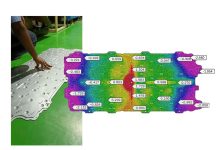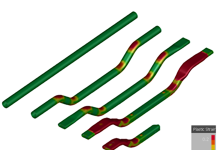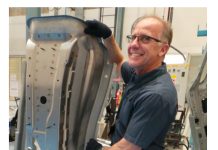When a closed section part is designed for manufacture, part shape, material grade, and wall thickness are often driven by the proposed hydroforming technology. Historically, suppliers dictate which process would be applied. Suppliers may specialize in one process over another; most common technology has been High-Pressure Hydroforming (HPH). However, as multi-pressure sequenced (Low-Pressure Hydroforming or LPH) is now increasingly available, the question of “which hydroforming process to use” should be addressed. Is it possible to achieve higher quality, lower costs, and better performance of components in the finished product by using one process over another? For that reason, we conducted a case study to examine a proposed product design and find if more comprehensive evaluations of the product and process performance could be achieved.

Thinning and formability predictions for the High-Pressure Process
Advanced feasibility for the HPH process predicted potential formability failure and exceeded thinning limits. Part modifications and increased initial tube thickness would be needed in order to continue using the HPH process. Several product radii had to be increased from 8mm to 16mm. This additionally forced the translation of several pierced holes, which were too close to modified radii. Any change to this component affects the other components in the assembly. Initial tube thickness increased about 16%. Material cost has been greatly increased, as well as part weight, undermining one of the main reasons for the hydroform part design. Increasing the thickness also means higher forming pressures, limiting the production line options.

Needed part modifications to resolve HPH forming issues; increased part radii and hole relocation away from radii
The modified part is feasible, but “feasible” parts can still fail in production. During engineering, only one combination of the many potential production process variables is considered. Real production conditions change; therefore, “declared feasibility” cannot be guaranteed. A process window is needed for a stable production. By running a robustness check—multiple simulations where the sensitivity and influence of various process parameters can be evaluated—it is possible to find whether or not a safe process window exists.
During the robustness check, process variables such as tube thickness, yield strength, tensile strength, R- and n-values, and lube are varied within the accepted ranges to emulate the potential production variations over the life of the product.

High Pressure Hydroforming process capability and production noise influences
Two areas are found critical, where the specification limits for thinning are exceeded. Assuming a normal distribution of production noise, failure rates as high as 2.22% are possible. A Pareto chart shows the influence of process variables on thinning in the zones: tube initial thickness in one zone and lubrication condition at another. It means that incoming tube stock must have limited thickness variation; perhaps a tube stock grade could be ordered with a smaller tolerance range for thickness at an increased cost. Also lubrication and tooling surface at the production source will require high degrees of control, likely increasing tool manufacturing and maintenance cost.
Feasibility and robustness of Multi-Pressure Sequence process
The original product design was then evaluated under the assumption of a multi-pressure sequence (low-pressure hydroforming or LPH) process. This technology can be successfully used when, at each cross section, final-part developed section length differs from tube circumference by small values, less than 4% in this case. The simulated process is shown in the image below.

Thinning and Max. failure plots for the LPH process
Based on initial formability results, it appeared that no geometry modifications are required and the tube maintains initial expected thickness of 1.5mm. Due to LPH technology, initial tube outer diameter, OD, can be larger than for the HPH, because inner pressure during upper tool closing prevents tube pinching, resulting in a slight increase in part mass but also in much less thinning under pressure.
Lower thinning levels proved the part feasible with no product design changes. Furthermore, no adaptations or revisions of other parts in the assembly are required due to pierced holes repositioning. Preforming operations and axial feeding are eliminated, reducing tooling costs and reducing the material stock requirements when compared to HPH.

Process capability and production variables influence
Material properties, tube initial thickness, and lubrication are again varied to perform a robustness check, this time for LPH. We find out that thinning exceeds threshold limits in one area with a failure rate that could also reach as high as 2.22%. However, the Pareto chart indicates that initial tube thickness is not a governing factor for any variation, negating any need to special-order more expensive material with tighter production controls.
Lubrication is the most influential of the noise variables, indicating that lubrication during forming must be well-controlled and that tool surfaces require high degrees of finishing. This may increase tool manufacturing and maintenance costs.
Decision drivers

There is more to evaluating the effectiveness of a forming process than “passing or failing.” Forming success is dependent upon stress and strain, but also upon the potential costs for the process proposed, the robustness of the process and the ability to launch on time, and the performance of the part as-designed. Therefore, we should evaluate formed parts on the basis of more than one dimension of decision drivers linked to Cost, Lead Time, and Part Function.
Both processes are feasible, and each could produce acceptable part quality in production. In a typical engineering organization, whichever process was initially proposed is the most likely to go to production. A perceived cost difference was the rationale for proposing high-pressure hydroforming, eliminating the alternative process without a comprehensive evaluation could very likely result in lower part quality, reduced part function, and higher costs. However, after considering both methods, we might conclude that this product design is more favorable under the low-pressure hydroforming; contrary to initial assumptions.
| Decision Drivers | HPH | LPH | Advantage |
|---|---|---|---|
| Quality (forming) | Safe, after part changes. Thickness increase, radii increase, holes moved. Some localized thinning | Safe without part changes, larger OD tube can be used, more uniform thinning | LPH |
| Cost | Common tooling process, seems cheaper | Less common process; supplier specialization reduces competition, might cost more | HPH |
| Cost | Axial feed increases tube stock costs (scrap); sensitivity to material properties increases cost of tube stock | No axial feed reduces tube stock costs and scrap, slightly larger OD of tube | LPH |
| Cost | Process time for HPH slightly higher | Cycle time slightly faster | LPH |
| Function | Hole movement triggers changes in other components, might alter performance of part | No product changes required | LPH |
| Function | localization of thinning could lower performance | uniform material thinning distribution improves performance | LPH |
| Function | Radii variation may alter structure’s performance; CAE validation required | No product changes required | LPH |
| Lead time | Sensitivity to variation in stock thickness and lube causes rejects, increases tool tryout and production ramp-up times | Less sensitivity to production variation, only lube which can be controlled cheaply | LPH |
Conclusions
Both processes are feasible, and each could produce acceptable part quality in production. In a typical engineering organization, whichever process was initially proposed is the most likely to go to production. A perceived cost difference was the rationale for proposing high-pressure hydroforming, eliminating the alternative process without a comprehensive evaluation could very likely result in lower part quality, reduced part function, and higher costs. However, after considering both methods, we might conclude that this product design is more favorable under the low-pressure hydroforming; contrary to initial assumptions.













